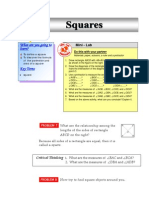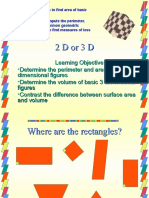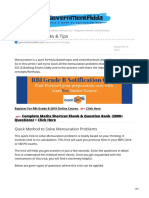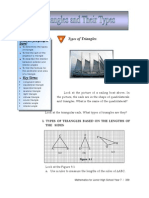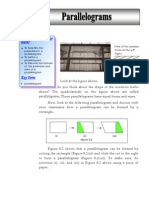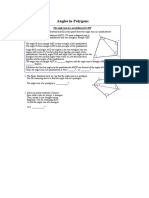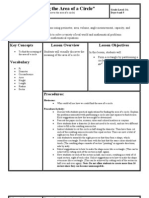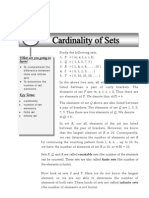What Are You Going To Learn?: Mini Lab
What Are You Going To Learn?: Mini Lab
Uploaded by
F X AGUS SISWANTOCopyright:
Available Formats
What Are You Going To Learn?: Mini Lab
What Are You Going To Learn?: Mini Lab
Uploaded by
F X AGUS SISWANTOOriginal Title
Copyright
Available Formats
Share this document
Did you find this document useful?
Is this content inappropriate?
Copyright:
Available Formats
What Are You Going To Learn?: Mini Lab
What Are You Going To Learn?: Mini Lab
Uploaded by
F X AGUS SISWANTOCopyright:
Available Formats
8.
What are you going to Look at the quadrilateral in Figure 8.4
learn? on the right. It is called rhombus. Do you
To describe the know why we call it belah ketupat in
properties a rhombus
To define of a rhombus
Indonesian?
To find out the formula
of the perimeter and
To know the properties of a rhombus,
area of a rhombus do the following mini-lab activity.
Key Terms: Figure 8.4
• rhombus
Mini Lab
Do this with your partner.
Materials: paper, scissors, and a ruler
A
B O D
(i) (ii) (iii) (iv) (v) (vi)
1. Draw a square and its diagonals.
2. Cut the square along the sides. (Figure (i))
3. Fold the square along one of its diagonals. (Figure (ii))
4. Draw in dotted lines as in Figure (iii) above.
5. Cut the fold along the dotted lines to obtain the shape in Figure (iv).
6. Open the fold to have a new quadrilateral as in Figure (v). The new quadrilateral is named
RHOMBUS.
7. Name it rhombus ABCD and the intersection of the diagonals as point O. (Figure (vi))
8. Based on the above actiity, observe the sides, angles and diagonals.
9. Find some properties of the rhombus. Explain.
Mathematics for Junior High School Year 7 / 323
Properties of rhombus are:
1. All sides are equal, which sides?
A 2. Opposite sides are parallel, which sides?
3. Vertical angles are equal, which angles?
≡ 4. The diagonals bisect the angles, which
B D angles?
O 5. Both diagonals are perpendicular and
≡ bisect each other. Mention them.
C
Rhombus ABCD
Figure 8.5
6. Diagonals bisect the rhombus or they are the axis lines.
Mention them.
7. The sum of the two adjacent angles is 180°. Mention the
angles.
A quadrilateral with four equal sides.
Rhombus
We can also say:
If both diagonals of a quadrilateral are perpendicular and bisect
each other, then it is called a rhombus.
Now think of how to construct the formula of the area of a
rhombus as follows.
Mini - Lab
WORK IN GROUPS
Materials: Grid paper, a pencil, and scissors.
Draw rhombus on the grid paper.
Cut the rhombus along the sides.
Draw one of the diagonals of the rhombus and cut a piece of paper along the diagonal.
What do you obtain?
Discuss with your classmates to answer the following questions.
1. What is the area of each isosceles triangle?
2. Do the two isosceles triangles have the same area?
3. What are the base and height of the two isosceles triangles?
4. In your own words, express the formula to find out the area and perimeter of a rhombus.
324 / Student’s Book – Quadrilaterals
Area and
• The area of a rhombus is equal to a half of the
Perimeter of a
product of the diagonals.
Rhombus
• The perimeter of a rhombus is four times the
length of the sides.
Suppose A is the area of a rhombus with diagonals
d1 1
d1 and d2, then A = × d1 × d2
2
Suppose P is the perimeter of a rhombus with the
d2
length of side s, then P = 4 × s
PQRS is a rhombus with diagonals PR = 6 cm, QS = 8 cm and
PQ = 5 cm. Calculate the area and perimeter of rhombus PQRS.
Solution:
S Given : PR = 8 cm, QS = 10 cm, and PQ = 5 cm.
Question : The area and perimeter of rhombus PQRS
Solution : Suppose the area of rhombus PQRS is L cm 2 ,
P R
then
1
A= × PR × QS
2
Q 1
A = × 8 × 10
2
A = 40
So, the area of rhombus PQRS is 40 cm2.
Suppose the perimeter PQRS is P cm,
then: P = 4 × PQ
P=4×5
P = 20
So, the perimeter of rhombus PQRS is 20 cm.
Mathematics for Junior High School Year 7 / 325
The figure on the right is for problems 1-4.
A
1. If ∠ABC = 132°, determine the measure of ∠ABD.
2. If ∠BDC = 25°, determine the measure of ∠ADC.
3. If ∠EBC = (2x+10)° and ∠ADE = (5x−20)°, B D
E
determine the value of x .
4. If ∠CBD = (2x+13)° and ∠EDA=(5x−20)°,
C
determine the value of x .
Given the following quadrilaterals are
rhombuses, determine the value of x and y.
135°
(4x-10)°
5. 6.
y° x° (2x+70)°
(2y)°
F
D
7. 8.
E
3,5cm O C 6cm
A G
2cm 5cm
H
B
Find the area of ABCD. Find the perimeter of EFGH.
9. The area of rhombus ABCD is 24 cm 2 and the length of
diagonal AC is 8 cm. What is the length of BD ?
Say whether the following statements are true or false.
10. ………… a. The opposite sides of a rhombus are parallel.
………… b. All angles of a rhombus are equal.
………… c. The sides of a rhombus are equal.
………… d. The opposite sides of a rhombus are equal.
326 / Student’s Book – Quadrilaterals
11. Suppose BEAC is a rhombus with BA = 6 cm and its
diagonals intersect at point H.
………… a. HA = 3 cm.
………… b. ∠BEH = ∠EBH.
………… c. Side BA is perpendicular to side EC .
………… d. The area of ΔBHE and the area of ΔAHC are
equal.
………… e. ∠CBE and ∠BCA are supplementary.
12. IJKL is a rhombus and its diagonals intersect at point O.
a. If ∠ILO = 63°, so ∠OIL =....°, ∠IJO =....°, ∠JOK =....°
b. If ∠ILO = (2x+15)° and ∠IJO = (3x−1)°, so the value of
x =...…
13. PQMN is a parallelogram. If PN = 7x−10 and PQ = 5x+6,
what is the value of x so that PQMN is a rhombus?
14. Critical Thinking. If ABCD is a rhombus, how many
symmetrical lines does rhombus ABCD have? State your
answer.
15. Is a rhombus also a parallelogram? Explain.
16. Is a parallelogram also a rhombus? Explain.
17. The lengths of the diagonals of a rhombus are 16 cm and 12
cm. Calculate the area of the rhombus.
18. A rhombus has the perimeter of 52 m. Find the length of
the sides of the rhombus.
19. The area of a rhombus is 36 cm 2 . If the proportion of the
diagonals is 1:2, what are the lengths of the diagonals?
Mathematics for Junior High School Year 7 / 327
328 / Student’s Book – Quadrilaterals
You might also like
- Rea An: Where You're GoingDocument58 pagesRea An: Where You're GoingTanvi VaddeNo ratings yet
- MTK Chapter 8 PDFDocument36 pagesMTK Chapter 8 PDFSmpnsatubontang KaltimNo ratings yet
- What Are You Going To Learn?: Mini - LabDocument8 pagesWhat Are You Going To Learn?: Mini - LabF X AGUS SISWANTONo ratings yet
- UntitledDocument12 pagesUntitledJessee Claire FolloscoNo ratings yet
- Buksis 8Document8 pagesBuksis 8F X AGUS SISWANTONo ratings yet
- 6.4 RhombusesDocument86 pages6.4 Rhombuseschellemartinez22No ratings yet
- RhombusDocument7 pagesRhombusRetchel ManguilimotanNo ratings yet
- DLL Theorems On RhombusDocument7 pagesDLL Theorems On RhombusPatrick Guerra100% (1)
- Heep 211Document28 pagesHeep 211Ansh MaldeNo ratings yet
- Properties of A RhombusDocument4 pagesProperties of A Rhombusapi-140032165No ratings yet
- 6 4 Rhombuses Rectangles and SquaresDocument14 pages6 4 Rhombuses Rectangles and SquaresJuztine ReyesNo ratings yet
- 6 - 4 Rhombuses - Rectangles and SquaresDocument14 pages6 - 4 Rhombuses - Rectangles and SquaresSafari DamaNo ratings yet
- Properties of A RhombusDocument4 pagesProperties of A Rhombusapi-150547803No ratings yet
- STD 2 1fDocument66 pagesSTD 2 1fAinah JovenNo ratings yet
- Mathematics: Quarter 3 - Module 2Document18 pagesMathematics: Quarter 3 - Module 2ThereseRubi LibresNo ratings yet
- Theorems On The Different Kinds of Parallelogram, Midline, Trapezoid and KiteDocument5 pagesTheorems On The Different Kinds of Parallelogram, Midline, Trapezoid and KiteCat PusaNo ratings yet
- Mensuration Tricks and TipsDocument40 pagesMensuration Tricks and TipsShobha AkulaNo ratings yet
- What Are You Going To Learn?: of TrianglesDocument20 pagesWhat Are You Going To Learn?: of TrianglesF X AGUS SISWANTONo ratings yet
- Theorems On RhombusDocument16 pagesTheorems On RhombusAnjielene SolanoNo ratings yet
- QuadrilateralDocument28 pagesQuadrilateralDebbie Rose ToledanoNo ratings yet
- Properties of A RhombusDocument4 pagesProperties of A Rhombusapi-150547803No ratings yet
- MATH02E Module 4Document37 pagesMATH02E Module 4einahbellissimoNo ratings yet
- Packets 2 SolidsDocument19 pagesPackets 2 SolidsNeldor A. MosquiteNo ratings yet
- Mensuration - 3 advancedDocument9 pagesMensuration - 3 advancedsurendra reddyNo ratings yet
- Chapter 5 Lesson 5 Rhombus and SquareDocument17 pagesChapter 5 Lesson 5 Rhombus and SquareJodi AlcarazNo ratings yet
- Circles Pythagoras and Trigonometry The Secondary VersionDocument91 pagesCircles Pythagoras and Trigonometry The Secondary VersionTonluck Kaimak100% (2)
- RHOMBUSDocument26 pagesRHOMBUSMa. Carla FernandezNo ratings yet
- Geometric Figures & Their Formula Counterparts: Lecture by Ms. Lexi 12 Grade GeometryDocument22 pagesGeometric Figures & Their Formula Counterparts: Lecture by Ms. Lexi 12 Grade Geometryapi-544940455No ratings yet
- 3rd Periodical Test in Math 4 With TOSrev.01Document5 pages3rd Periodical Test in Math 4 With TOSrev.01Teacherbhing MitrcNo ratings yet
- Directions: Consider The Table Below. Given Each Figure, Recall The Definition of Each Quadrilateral and Write It On The Space ProvidedDocument19 pagesDirections: Consider The Table Below. Given Each Figure, Recall The Definition of Each Quadrilateral and Write It On The Space ProvidedJaninne Villa Del ReyNo ratings yet
- 47. Surface Area of a Pyramid With a Rectangular BaseDocument7 pages47. Surface Area of a Pyramid With a Rectangular BaseYe XuiNo ratings yet
- Understanding QuadrilateralsDocument23 pagesUnderstanding QuadrilateralsAnsh Singh100% (1)
- Solid Geom ReportDocument62 pagesSolid Geom ReportJovito OriolaNo ratings yet
- Grade 9-Demonstration (Theorems On Rectangle and Rhombus) : University of San Jose-RecoletosDocument7 pagesGrade 9-Demonstration (Theorems On Rectangle and Rhombus) : University of San Jose-RecoletosChristine Mae FrioloNo ratings yet
- Quadrilaterals Digital TextDocument14 pagesQuadrilaterals Digital TextAmruthaNo ratings yet
- 5b CircumferenceDocument8 pages5b Circumferenceapi-256386911No ratings yet
- What Are You Going To Learn?: Parallelograms. Those Parallelograms Have Equal Forms and SizesDocument6 pagesWhat Are You Going To Learn?: Parallelograms. Those Parallelograms Have Equal Forms and SizesF X AGUS SISWANTONo ratings yet
- Module 2 Properties of QuadrilateralsDocument24 pagesModule 2 Properties of QuadrilateralszhiancarlNo ratings yet
- You Will Learn To Identify and Use The: Properties of Rectangles, Rhombi, and SquaresDocument8 pagesYou Will Learn To Identify and Use The: Properties of Rectangles, Rhombi, and Squaresapi-257637196No ratings yet
- Periodical Test q1 Math 4 MatatagDocument7 pagesPeriodical Test q1 Math 4 Matatagchristinedevera1222No ratings yet
- Plane Figures: Group 1Document49 pagesPlane Figures: Group 1Danielle Kate MadridNo ratings yet
- AsdfgDocument13 pagesAsdfgwardatul jannahNo ratings yet
- Eng mathDocument21 pagesEng mathJosef PlenoNo ratings yet
- Geometry in SpaceDocument15 pagesGeometry in SpaceSislia UtinaNo ratings yet
- CH 16Document29 pagesCH 16Ankita KumariNo ratings yet
- 0 Polygons BookletDocument30 pages0 Polygons BookletRenier Palma CruzNo ratings yet
- Circles Rules - SATDocument12 pagesCircles Rules - SATSmart Learn for MBA & PhDNo ratings yet
- Grade 6 GeometryDocument6 pagesGrade 6 GeometryNguyen Thi Thien MinhNo ratings yet
- GR 7 Unit 4 CirclesDocument36 pagesGR 7 Unit 4 Circlesvasantha.singojiNo ratings yet
- mATH 6 Q3 W8 Day 1Document19 pagesmATH 6 Q3 W8 Day 1Jocelyn MulatoNo ratings yet
- Math - Lesson2 - Properties of Special ParallelogramDocument9 pagesMath - Lesson2 - Properties of Special ParallelogramFree TemplatesNo ratings yet
- Detailed Lesson Plan in Mathematics IV Plane FigurDocument7 pagesDetailed Lesson Plan in Mathematics IV Plane FigurLaLa Fuller100% (1)
- SH Wet ADocument2 pagesSH Wet Ahemanu18911No ratings yet
- 6417a2e5873e31001c5259eb-1679270800-Lesson Plan in Mathematics 3Document12 pages6417a2e5873e31001c5259eb-1679270800-Lesson Plan in Mathematics 3Angela BuagasNo ratings yet
- Q3-Week-2-Special-Parallelograms_V2Document35 pagesQ3-Week-2-Special-Parallelograms_V2marianeperillaNo ratings yet
- 6-5 Rhombi and SquaresDocument43 pages6-5 Rhombi and Squareskidgta72No ratings yet
- g6 06 02Document6 pagesg6 06 02Anshul BadoniNo ratings yet
- C 05 GeometryDocument58 pagesC 05 GeometryVeera AnjuNo ratings yet
- Class 4 Maths KeyDocument41 pagesClass 4 Maths KeyshanmuganathanNo ratings yet
- MathsTraks: Geometry: A Collection of Blackline Masters for ages 11-14From EverandMathsTraks: Geometry: A Collection of Blackline Masters for ages 11-14No ratings yet
- Id Rights Advocated by Instinct and Established by AlshariaDocument61 pagesId Rights Advocated by Instinct and Established by AlshariaF X AGUS SISWANTONo ratings yet
- Wala' Dan Baro' Dalam IslamDocument44 pagesWala' Dan Baro' Dalam IslamdanzdiptaNo ratings yet
- Alamat Jurnal InternasionalDocument1 pageAlamat Jurnal InternasionalF X AGUS SISWANTO100% (1)
- Manual Minitab 16 Eng PDFDocument122 pagesManual Minitab 16 Eng PDFhans_106No ratings yet
- Wahai PuterikuDocument5 pagesWahai PuterikuDwi Nugraha Abu MuhammadNo ratings yet
- References FinalDocument5 pagesReferences FinalF X AGUS SISWANTONo ratings yet
- 100 Unit 1: Section OneDocument9 pages100 Unit 1: Section Oneainnur istafadaNo ratings yet
- Kalender Puasa Sunnah Tahun 1900-2078 Rev 01Document1 pageKalender Puasa Sunnah Tahun 1900-2078 Rev 01Kabir BediNo ratings yet
- Cover KuningDocument1 pageCover KuningF X AGUS SISWANTONo ratings yet
- Hal Masing Masing BabDocument9 pagesHal Masing Masing BabF X AGUS SISWANTONo ratings yet
- Raport 7J Ganjil2009Document2 pagesRaport 7J Ganjil2009fxagussisNo ratings yet
- What Are You Going To Learn?: of TrianglesDocument20 pagesWhat Are You Going To Learn?: of TrianglesF X AGUS SISWANTONo ratings yet
- Cover KuningDocument1 pageCover KuningF X AGUS SISWANTONo ratings yet
- What Are You Going To Learn?: Parallelograms. Those Parallelograms Have Equal Forms and SizesDocument6 pagesWhat Are You Going To Learn?: Parallelograms. Those Parallelograms Have Equal Forms and SizesF X AGUS SISWANTONo ratings yet
- What Are You Going To Learn?: Drawing Right Triangles, Isosceles Triangles and Equilateral TrianglesDocument8 pagesWhat Are You Going To Learn?: Drawing Right Triangles, Isosceles Triangles and Equilateral TrianglesF X AGUS SISWANTONo ratings yet
- Cover BiruDocument1 pageCover BiruF X AGUS SISWANTONo ratings yet
- What Are You Going To Learn?Document6 pagesWhat Are You Going To Learn?F X AGUS SISWANTONo ratings yet
- What Are You Going To Learn?: TrapezoidDocument6 pagesWhat Are You Going To Learn?: TrapezoidF X AGUS SISWANTONo ratings yet
- What Are You Going To Learn?: Definition of Complement of SetsDocument10 pagesWhat Are You Going To Learn?: Definition of Complement of SetsF X AGUS SISWANTONo ratings yet
- Position of Two Lines: What Are You Going To Learn?Document18 pagesPosition of Two Lines: What Are You Going To Learn?F X AGUS SISWANTONo ratings yet
- What Are You Going To Learn?: Drawing AnglesDocument8 pagesWhat Are You Going To Learn?: Drawing AnglesF X AGUS SISWANTONo ratings yet
- What Are You Going To Learn?: The Union of Two SetsDocument12 pagesWhat Are You Going To Learn?: The Union of Two SetsF X AGUS SISWANTONo ratings yet
- What Are You Going To Learn?: À To Comprehend Inverse ProportionDocument6 pagesWhat Are You Going To Learn?: À To Comprehend Inverse ProportionF X AGUS SISWANTONo ratings yet
- What Are You Going To Learn?: Concept of The Intersection of Two SetsDocument14 pagesWhat Are You Going To Learn?: Concept of The Intersection of Two SetsF X AGUS SISWANTONo ratings yet
- What Are You Going To Learn?: Universal Set Universal SetDocument14 pagesWhat Are You Going To Learn?: Universal Set Universal SetF X AGUS SISWANTONo ratings yet
- What Are You Going To Learn?: Scaled DrawingsDocument10 pagesWhat Are You Going To Learn?: Scaled DrawingsF X AGUS SISWANTONo ratings yet
- What Are You Going To Learn?Document4 pagesWhat Are You Going To Learn?F X AGUS SISWANTONo ratings yet
- What Are You Going To Learn?: Ali Has 9 Books, While Lia Has 6 BooksDocument5 pagesWhat Are You Going To Learn?: Ali Has 9 Books, While Lia Has 6 BooksF X AGUS SISWANTONo ratings yet


